The following explanation is the one to have gathered the item which was investigated when making a thermometer this time.

 Why is it possible to measure a temperature with the diode? Why is it possible to measure a temperature with the diode?
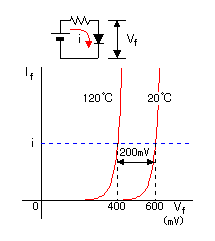
The forward voltage of the silicon diode changes in the coefficient of -2mV/°C when the temperature with joint changes.
Generally, the 20°C forward voltage is about 600 mV. The forward voltage becomes about 400 mV(600mV-(2mV/°C x 100°C)) when the temperature with joint rises by 100°C and becomes 120°C. At the thermometer this time, it is displaying the change of this voltage as the temperature. The temperature range which it is possible to measure is within the allowable temperature of the diode. It depends on the kind of the diode but it is possible from about -20°C to 150°C. Generally, a diode is enclosed with the package of glass or plastic. So, even if the ambient temperature changes, the voltage of the diode doesn't sometimes change immediately.

 ICL7136 is what IC? ICL7136 is what IC?
The ICL7136 is the IC of the CMOS that the function to measure the voltage of the input correctly, the function to control the LCD(Liquid Crystal Display) and so on are housed in 1 chip. It is possible to measure the voltage to ±200 mV or ±2 V. The ICL7136 is the type which uses the LCD as the display. There is the ICL7137 in the type which uses the LED for the display. The control signal of the LCD is the square wave of the frequency is about 60 Hz(48KHz/800) and the voltage is 5.5Vp-p.
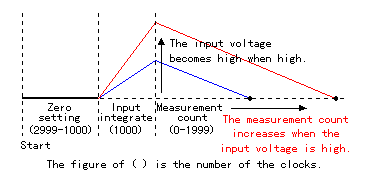 The measurement of the voltage is done in converting input voltage to the energy with constant time. It is possible to measure correctly with this way. When measuring, it doesn't take in energy from the input. Make the energy(Quantity of electric charge which is stored up to the capacitor) which is equivalent to the input voltage occur inside and the way of measuring it is adopted. Because it is, the input impedance is very high(More than 1 G-ohm?) and the input electric current flows hardly. The ICL7136 does the measurement process like the figure on the right the about three times in the 1 second. The measurement of the voltage is done in converting input voltage to the energy with constant time. It is possible to measure correctly with this way. When measuring, it doesn't take in energy from the input. Make the energy(Quantity of electric charge which is stored up to the capacitor) which is equivalent to the input voltage occur inside and the way of measuring it is adopted. Because it is, the input impedance is very high(More than 1 G-ohm?) and the input electric current flows hardly. The ICL7136 does the measurement process like the figure on the right the about three times in the 1 second.
4000 clocks/time = 4000 x (4/48000Hz) = 0.33 seconds/time
In the zero setting phase, the charging to the capacitor (CREF) for the reference voltage is done at the same time as setting the measurement circuit to the zero voltage.
In the input integration phase, the energy which is equivalent to the input voltage is stored up at the capacitor (CAZ) for the measurement.
In the measurement count phase, making discharge the energy of the capacitor (CAZ) for the measurement and the capacitor (CREF) for the reference voltage and the time which becomes the zero voltage is measured.
In the measurement count phase, because the energy of CAZ and CREF is discharged, the maximum of the measurement can be adjusted by changing the quantity with the energy which is stored up in CREF.
The thermometer this time sets the display of the cold side in VR2(zero adjust) and sets the display of the hot side in VR1(scale factor adjust).
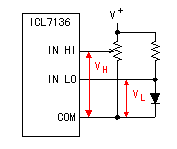 To have explained before, the forward voltage of the diode has the characteristic with the falling voltage when the temperature rises(-2mV/°C). When displaying the forward voltage of the diode as the temperature, the figure of the display falls when the temperature rises. In such a display, it isn't possible to use as the thermometer. To have explained before, the forward voltage of the diode has the characteristic with the falling voltage when the temperature rises(-2mV/°C). When displaying the forward voltage of the diode as the temperature, the figure of the display falls when the temperature rises. In such a display, it isn't possible to use as the thermometer.
The ICL7136 has the input terminals of "High" and "Low". Also, it has the electric grounding (Common). The COM is the electric grounding to be making inside, being different from the side of the negative of the power supply. As for the measurement of the input voltage, it measures the potential difference between "IN HI" and "IN LO". In case of the figure on the left, the potential difference of HI and LO becomes VH-VL. The potential difference becomes big when the forward voltage (VL) of the diode becomes small with the temperature rise. Therefore, the displayed figure rises.

 The liquid crystal works how? The liquid crystal works how?
The liquid crystal is in the condition to have the nature of the liquid(Fluidity) and the nature of the solid(Crystal). There is not material which is called the liquid crystal.
I learned the following at the school. When the temperature is low, the object becomes the solid condition. When the temperature rises, it becomes the liquid condition. Moreover, when the temperature rises, it becomes the gaseous condition.
In the liquid crystal condition, it is the neutrality of the solid and the liquid.
The material of the biphenyl of some kind which has this nature at the normal temperature is used for the liquid crystal display. With the material which we know well, the one of the liquid crystal condition is the soap water or the cuttlefish ink... They are the material to have the structure of crystals while being the liquid. Because the cuttlefish ink is always black, it isn't possible to use for the indicator. (It may be possible to use if devising.)
In the following explanation, the word "the liquid crystal" means "the material which has the liquid crystal condition".
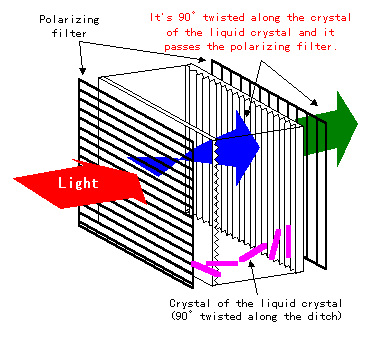 The structure of the TN(Twisted Nematic) liquid crystal display puts the polarizing filter which makes the vibration of the light the constant direction at the front and the back, arranges the board which has the small ditch among it and it encloses the liquid crystal into it. The polarizing filter and the ditch board on the side of the front and on the side of the back are making shift by the 90 degrees. When there is not liquid crystal in the ditch board, because the polarizing filter is 90 degrees shifted, the light can not pass. However, the light is 90 degrees twisted with the liquid crystal when pouring the liquid crystal in the ditch board and the light gets to pass. It is the strange phenomenon. The structure of the TN(Twisted Nematic) liquid crystal display puts the polarizing filter which makes the vibration of the light the constant direction at the front and the back, arranges the board which has the small ditch among it and it encloses the liquid crystal into it. The polarizing filter and the ditch board on the side of the front and on the side of the back are making shift by the 90 degrees. When there is not liquid crystal in the ditch board, because the polarizing filter is 90 degrees shifted, the light can not pass. However, the light is 90 degrees twisted with the liquid crystal when pouring the liquid crystal in the ditch board and the light gets to pass. It is the strange phenomenon.
This is because the crystal of the liquid crystal stands in line along the ditch board. The row of the crystal is 90 degrees twisted at the front and the back. Because the light moves ahead along the crystal, it is 90 degrees twisted.
When not applying the voltage to the liquid crystal display, it is in this condition. It is in the condition which can be seen with the back of the display being transparent.
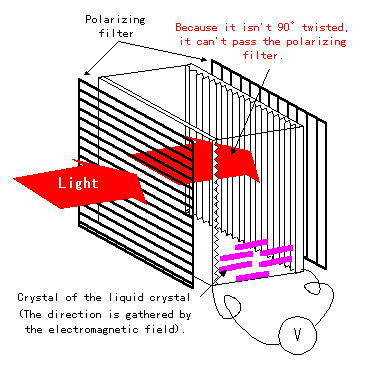 The crystal of the liquid crystal matches the constant direction in the influence in the electromagnetic field when applying the electricity to both sides of the liquid crystal. Then, the light which was twisted with the liquid crystal moves ahead straight without being twisted and it is interrupted with the polarizing filter at the back side and it gets not to pass. It becomes the condition which can be blackly seen. The crystal of the liquid crystal matches the constant direction in the influence in the electromagnetic field when applying the electricity to both sides of the liquid crystal. Then, the light which was twisted with the liquid crystal moves ahead straight without being twisted and it is interrupted with the polarizing filter at the back side and it gets not to pass. It becomes the condition which can be blackly seen.
In case of the electromagnetic field of the direct current, within the several seconds, the crystal returns to the original place and the light becomes the again passing condition. Because it is, to continue the condition which interrupts the light, it makes the electromagnetic field with the alternating current and the magnetic field must be always changed.
The thermometer this time makes the electromagnetic field with the 60-Hz square wave and has the display of the figure.
Because the direction of the crystal of the liquid crystal changes with the electromagnetic field, the electric current flows hardly. Because the figure can be displayed without consuming the electric power, it is convenient for the indicator of the watch.

Nematic is the word which means "Thread" in Greek.
Recently, the color liquid crystal is often used for the display of the PC. The principle is the same. It makes the condition which can be seen with the back being transparent, it is not or it is. The liquid crystal itself isn't luminous. Because it is, the way of controlling the light of the back light which passes the film of the red, the green, the blue with the liquid crystal is adopted. The advanced technique is used to display the small display stable beautifully.
 |